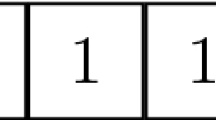Abstract
We continue the investigation of P colonies introduced in [4], a class of abstract computing devices composed of independent agents, acting and evolving in a shared environment. We are introducing 2D P colonies with a 2D environment where the agents are located. Agents have limited information about the contents of the environment where they can move in four directions. To present computations of 2D P colonies we construct a simulation environment.
Access this chapter
Tax calculation will be finalised at checkout
Purchases are for personal use only
Preview
Unable to display preview. Download preview PDF.
Similar content being viewed by others
References
Csuhaj-Varjú, E., Kelemen, J., Kelemenová, A., Păun, G., Vaszil, G.: Cells in environment: P colonies. Multiple-Valued Logic and Soft Computing 12(3-4), 201–215 (2006)
Gardner, M.: Mathematical Games - The fantastic combinations of John Conway’s new solitaire game ”life”. Scientific American 223, 120–123 (1970/2010) ISBN 0-89454-001-7 (Archived from the original on June 03, 2009) (retrieved June 26, 2011)
Kelemen, J., Kelemenová, A.: On P colonies, a biochemically inspired model of computation. In: Proc. of the 6th International Symposium of Hungarian Researchers on Computational Intelligence, Budapest TECH, Hungary, pp. 40–56 (2005)
Kelemen, J., Kelemenová, A., Păun, G.: Preview of P colonies: A biochemically inspired computing model. In: Bedau, M., et al. (eds.) Workshop and Tutorial Proceedings, Ninth International Conference on the Simulation and Synthesis of Living Systems, ALIFE IX, Boston, Mass, pp. 82–86 (2004)
Păun, G.: Computing with membranes. Journal of Computer and System Sciences 61, 108–143 (2000)
Păun, G.: Membrane computing: An introduction. Springer, Berlin (2002)
Păun, G., Rozenberg, G., Salomaa, A. (eds.): The Oxford Handbook of Membrane Computing. Oxford University Press (2009)
P systems web page (May 10, 2012), http://ppage.psystems.eu
Author information
Authors and Affiliations
Editor information
Editors and Affiliations
Rights and permissions
Copyright information
© 2013 Springer-Verlag Berlin Heidelberg
About this paper
Cite this paper
Cienciala, L., Ciencialová, L., Perdek, M. (2013). 2D P Colonies. In: Csuhaj-Varjú, E., Gheorghe, M., Rozenberg, G., Salomaa, A., Vaszil, G. (eds) Membrane Computing. CMC 2012. Lecture Notes in Computer Science, vol 7762. Springer, Berlin, Heidelberg. https://doi.org/10.1007/978-3-642-36751-9_12
Download citation
DOI: https://doi.org/10.1007/978-3-642-36751-9_12
Publisher Name: Springer, Berlin, Heidelberg
Print ISBN: 978-3-642-36750-2
Online ISBN: 978-3-642-36751-9
eBook Packages: Computer ScienceComputer Science (R0)




